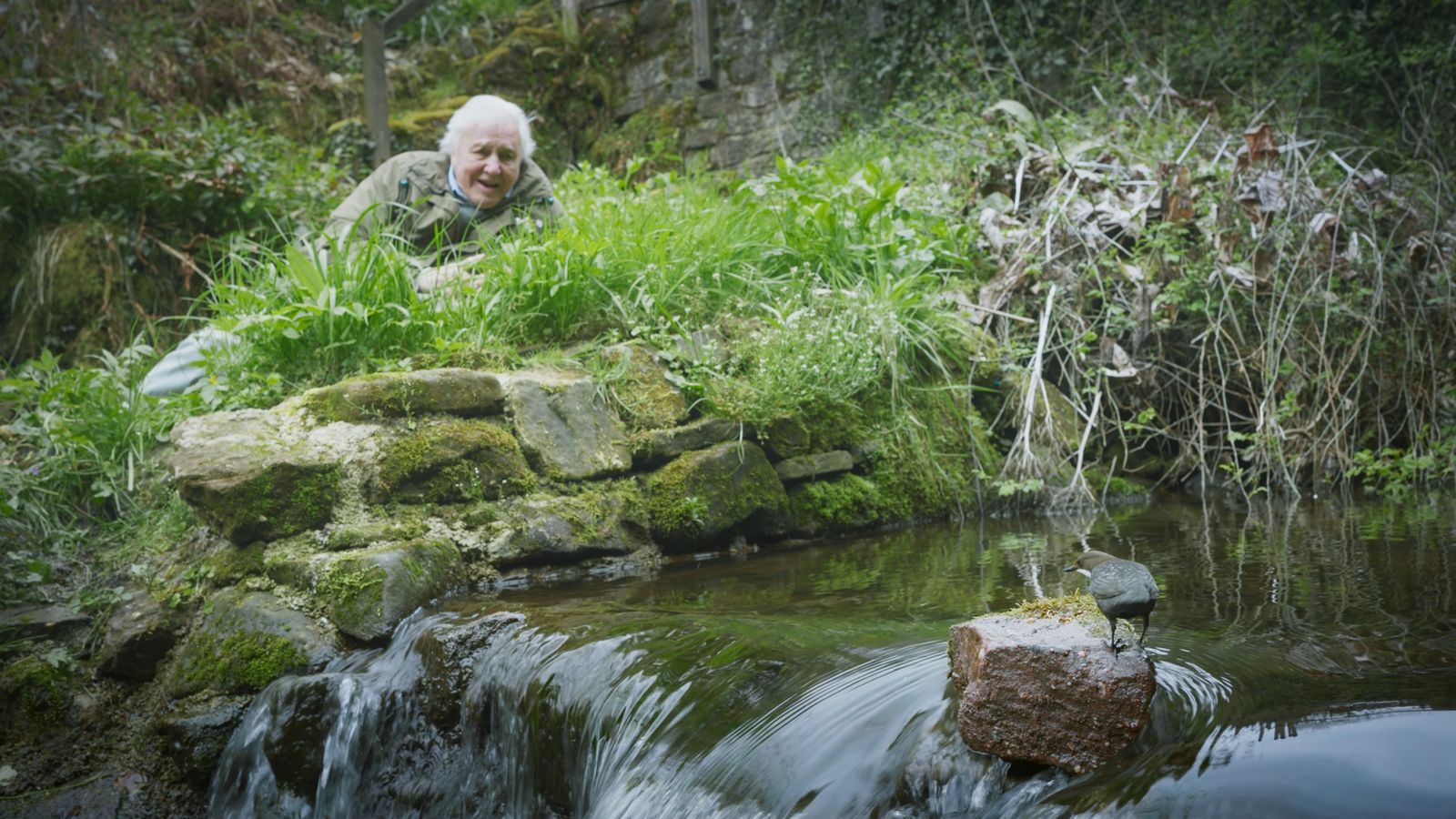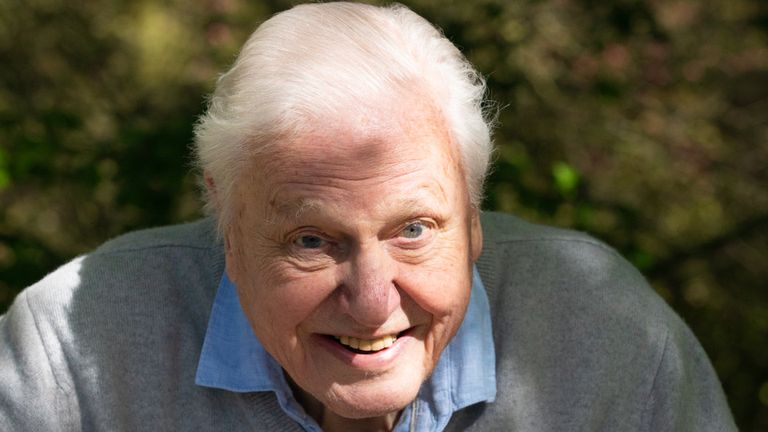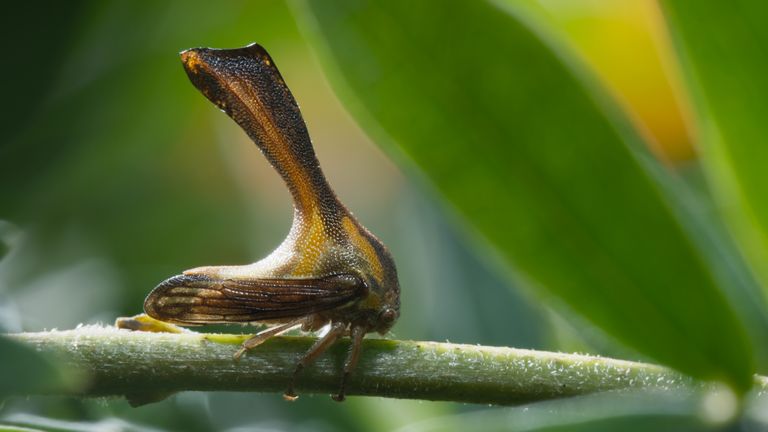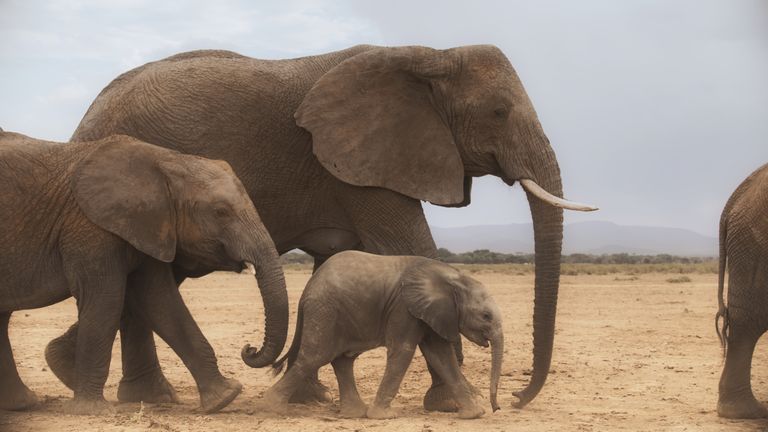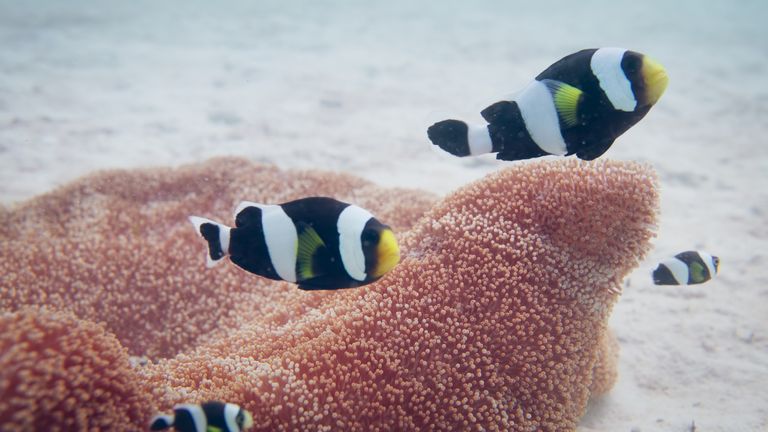At 97, Sir David Attenborough is a man still happy to crawl on his belly through wet grass to get his shot.
For his latest project, Secret World Of Sound, the world-renowned naturalist and broadcaster explores the ways that animals hear and produce sound, using cutting-edge technology to record noises from nature – with some captured on film for the first time.
Attenborough’s long-time collaborator, and the show’s series producer, Sharmila Choudhury tells Sky News: “David keeps us on our toes. He sets the bar very high. And that’s a good thing.
“I think he work still works harder than most of us, usually seven days a week… When he commits himself to something, he gives it 100%.”
Joining the team for filming in the Wye Valley in Monmouth to capture the song of a wild dipper, Attenborough found himself lying on the damp ground hoping that the small bird would show up.
Truly at one with nature, he didn’t have long to wait.
Choudhury explains: “He crawled through the grass to get into the best position, and was all up for it… We didn’t want to leave him lying in the wet grass for hours.
“Miraculously, and this often happens when David arrives on location, the sun suddenly burst through the clouds.
“The dipper flew in. David smiled and delivered his lines of what he wanted to say, you know, smoothly in one go. It’s amazing.”
‘It hits you in the core’
For the same episode, Attenborough explains how bees are struggling with modern fertilisers and climate change.
Choudhury says: “Him looking straight to camera and delivering a message like that is so powerful. It literally hits you in the core.”
Calling him an “inspiration,” and praising his “unrivalled” breadth of knowledge, she adds: “And he obviously has a fabulous voice and style of delivery, which is the cherry on the cake of any natural history program.”
A-three-part series, the documentary studies animal behaviour, breaking the sounds they make down into four functions – finding a mate, looking after young, hunting for food or avoiding becoming prey.
Technology worthy of 007
Some of the technology used in the series was borrowed from other walks of life, while other bits of kit were of true James Bond status.
Choudhury says: “We used everything from the tiniest microphone the size of your fingernail, that you could put inside a bird nest or a beehive, to super sensitive hydrophones that you can put underwater to record, the faintest communications between fish.
“There were also a couple of, gadgets that were actually developed for other industries – the gas industry, or for espionage purposes, that we thought might help us to listen in on sounds that we don’t normally get to hear.”
One of those gadgets was the laser vibrometer – a machine which shoots out a laser beam to detect any vibrations caused by noise and amplifies them, so they are audible to the human ear.
It was used to capture the love song of a pair of amorous tree hoppers in Costa Rica.
While sound was the focus of the documentary, another theme became impossible to ignore while filming.
‘Every single shoot was impacted by climate change’
Choudhury says: “The biggest challenge, without any doubt, was climate change. It’s something that we’ve seen creep in on us over the years.
“I’ve been making wildlife films for over 30 years. And in the last decade or so, more and more shoots have been impacted by climate change.
“That means animals that would have been predictable in their movements, say, their migrations or where they would be, or the time of year they’d be breeding, are not doing the usual things anymore.
“It started off with one or two parts of the world, or one or two shoots being affected by this. But on this particular series, every single shoot was impacted by climate change.
That made filming very difficult, and it was very distressing to see the animals suffering in this new world.”
‘The elephants were so stressed’
One example was the team’s trip to Amboseli National Park in Kenya to film elephants.
The plan had been to shoot a story about how mothers and babies communicate with each other – but when they arrived following Kenya’s worst drought in 40 years, they found the elephants in an awful plight.
“The elephants were behaving very differently to before. They had split up into tiny herds and every night they would go out of the park to surrounding fields to try and find some food.
“Every morning they would walk back into the waterhole in the middle of the park, and they would walk single file heads down, absolutely dejected. They didn’t make a single sound.
“The animals were so stressed, they had no energy left to talk to each other effectively.
“After we left, Kenya and Amboseli experienced the worst deaths of wildlife, including elephants, recorded history and that was clearly a result of climate change.”
‘Buy the coral reefs a little time’
But there was some hope amid the devastation being caused to the natural world by the climate crisis – and this was very much set in the world of sound.
During filming, the team discovered an Australian scientist whose research had found that by playing the sound of a healthy coral reef at the site of a dying reef it could help regenerate it and bring back some of the fish.
Click to subscribe to ClimateCast with Tom Heap wherever you get your podcasts
Choudhury explains: “They are hopeful that they might be able to buy coral reefs a little bit of time whilst we tackle climate change.
“It won’t be a solution in the long run because the reef will continue to die off if the oceans continue to warm. But it’s a little ray of hope, at a time when we so badly needed.”
Watch the full interview with Sharmila Choudhury on The Climate Show with Tom Heap, Saturday and Sunday at 3.30 and 7.30pm on Sky News.
Secret World Of Sound With David Attenborough is streaming on Sky Nature and NOW.
